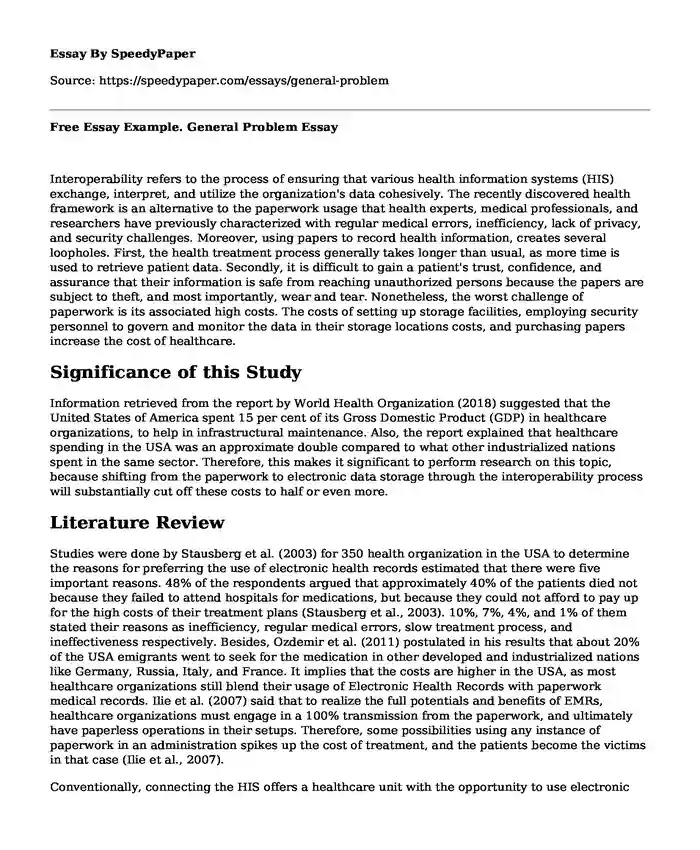
| Essay type: | Problem solution essays |
| Categories: | Information technologies Healthcare policy Community health Essays by wordcount |
| Pages: | 4 |
| Wordcount: | 896 words |
Interoperability refers to the process of ensuring that various health information systems (HIS) exchange, interpret, and utilize the organization's data cohesively. The recently discovered health framework is an alternative to the paperwork usage that health experts, medical professionals, and researchers have previously characterized with regular medical errors, inefficiency, lack of privacy, and security challenges. Moreover, using papers to record health information, creates several loopholes. First, the health treatment process generally takes longer than usual, as more time is used to retrieve patient data. Secondly, it is difficult to gain a patient's trust, confidence, and assurance that their information is safe from reaching unauthorized persons because the papers are subject to theft, and most importantly, wear and tear. Nonetheless, the worst challenge of paperwork is its associated high costs. The costs of setting up storage facilities, employing security personnel to govern and monitor the data in their storage locations costs, and purchasing papers increase the cost of healthcare.
Significance of this Study
Information retrieved from the report by World Health Organization (2018) suggested that the United States of America spent 15 per cent of its Gross Domestic Product (GDP) in healthcare organizations, to help in infrastructural maintenance. Also, the report explained that healthcare spending in the USA was an approximate double compared to what other industrialized nations spent in the same sector. Therefore, this makes it significant to perform research on this topic, because shifting from the paperwork to electronic data storage through the interoperability process will substantially cut off these costs to half or even more.
Literature Review
Studies were done by Stausberg et al. (2003) for 350 health organization in the USA to determine the reasons for preferring the use of electronic health records estimated that there were five important reasons. 48% of the respondents argued that approximately 40% of the patients died not because they failed to attend hospitals for medications, but because they could not afford to pay up for the high costs of their treatment plans (Stausberg et al., 2003). 10%, 7%, 4%, and 1% of them stated their reasons as inefficiency, regular medical errors, slow treatment process, and ineffectiveness respectively. Besides, Ozdemir et al. (2011) postulated in his results that about 20% of the USA emigrants went to seek for the medication in other developed and industrialized nations like Germany, Russia, Italy, and France. It implies that the costs are higher in the USA, as most healthcare organizations still blend their usage of Electronic Health Records with paperwork medical records. Ilie et al. (2007) said that to realize the full potentials and benefits of EMRs, healthcare organizations must engage in a 100% transmission from the paperwork, and ultimately have paperless operations in their setups. Therefore, some possibilities using any instance of paperwork in an administration spikes up the cost of treatment, and the patients become the victims in that case (Ilie et al., 2007).
Conventionally, connecting the HIS offers a healthcare unit with the opportunity to use electronic health records which is more safe, secure and effective. According to Boonstra and Broekhuis (2010), the implication that it creates is that hospitals will not complain of regular patient data loss as personal health information (PHI) will be stored electronically. Besides, Ludwick and Doucette (2009) found that the modern technological advancements make it easy to integrate security elements during interoperability, to ensure that the organization's confidential information is kept safe and secure because access is restricted to specifically authorized individuals. Perhaps, using electronic health records will also eradicate the costs which are associated with paperwork.
Specific Research Problem/ Question
This research will investigate the various healthcare organization in Germany to determine whether they were partially or fully using the electronic system of storing patient's medical records. To address this problem, the research will answer the following questions, what is the cost of the various interoperability methodologies that healthcare institutions need to have when merging the Patient-generated health data (PGHD) and the EHR? How do the costs compare to the annual USA expenditure on healthcare infrastructural maintenance?
References
Boonstra, A., & Broekhuis, M. (2010). Barriers to the acceptance of electronic medical records by physicians from systematic review to taxonomy and interventions. BMC health services research, 10(1), 231. https://link.springer.com/article/10.1186/1472-6963-10-231
Ilie, V., Courtney, J. F., & Van Slyke, C. (2007, January). Paper versus electronic: Challenges associated with physicians' usage of electronic medical records. In Hawaii International Conference on System Sciences (Vol. 40, No. 5, p. 2307). IEEE. http://www.cse.msu.edu/~cse435/Handouts/EMR/paper-vs-emr.pdf
Ludwick, D. A., & Doucette, J. (2009). Adopting electronic medical records in primary care: lessons learned from health information systems implementation experience in seven countries. International journal of medical informatics, 78(1), 22-31. https://www.sciencedirect.com/science/article/pii/S1386505608000920
Ozdemir, Z., Barron, J., & Bandyopadhyay, S. (2011). An analysis of the adoption of digital health records under switching costs. Information Systems Research, 22(3), 491-503. https://pubsonline.informs.org/doi/abs/10.1287/isre.1110.0349
Stausberg, J., Koch, D., Ingenerf, J., & Betzler, M. (2003). Comparing paper-based with electronic patient records: lessons learned during a study on diagnosis and procedure codes. Journal of the American Medical Informatics Association, 10(5), 470-477. https://academic.oup.com/jamia/article-abstract/10/5/470/786520
World Health Organization. (2018). WHO expert consultation on rabies: third report (Vol. 1012). World Health Organization. https://books.google.com/books?hl=en&lr=&id=-nKyDwAAQBAJ&oi=fnd&pg=PR7&dq=world+health+organization+report+2018&ots=UpmLkqUJrK&sig=n2ZxNodPfPt5ud3RNK5f58FuGb0
Cite this page
Free Essay Example. General Problem. (2023, Nov 14). Retrieved from https://speedypaper.com/essays/general-problem
Request Removal
If you are the original author of this essay and no longer wish to have it published on the SpeedyPaper website, please click below to request its removal:
- Free Essay Example on Operations Management of the Nissan Company
- Optical Sector PEST Analysis Essay Example
- Free Essay on the Great Debaters Movie Research
- Free Essay on Why International Business is Very Important
- Analysis of Gilgamesh, Literary Essay for Students
- Essay Example on Offshore Oil and Gas Drilling
- The Victorious Youth Statute - Free Essay Example
Popular categories




